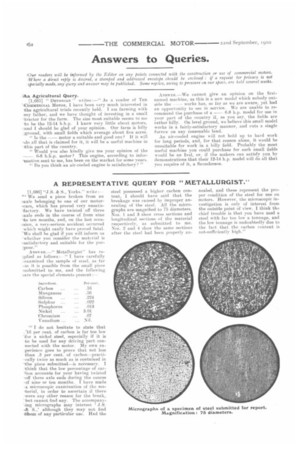A REPRESENTATIVE QUERY FOR "METALLURGIST."
Page 20

If you've noticed an error in this article please click here to report it so we can fix it.
1-1,686] "J.S. & S., Yorks." write :4" We send a piece broken from an :::axle belonging to one of our motor'ears, which has proved very unsatislactory. We have twisted off three -axle ends in the course of from nine to ten months, and, on the last occa'talon, a very-serious accident occurred -which might easily have proved fatal. We shall be glad if you will inform us 'whether you consider the material is z:satisfactt>ry and suitable for the pur?pose." ANsw en.—" Metallurgist" has revlied as follows:" I have carefully -examined the sample of steel, as far as it is possible from the small piece '‘.submitted to me, and the following re the special elements present:-
Ingredient. Per cent.
Carbon .16 Manganese .56 Silicon .224
-Sulphur ... .022
Phosphorus .013 Nickel ... 3.01 Chromium .07 Vanadium ... Nil.
I do not hesitate to state that ;16 per cent, of carbon is far too low ifor a nickel steel, especially if it is to be used for any driving part con-vetted with the motor. My own experience goes to prove that not less than .3 per cent, of carbon—practi lly twice as much as is contained in -the piece submitted—is necessary. I .think that the low percentage of cat'bon accounts for your having twisted =off three axle ends during the course :-a,f nine or ten months. I have made -a microscopic examination of the material, in order to ascertain if there were any other reason for the break, :but cannot find any. The accompany-ling micrographs may interest J.S. slt S.,' although they may not find *hem of any particular use. Had the
steel possessed a higher carbon content, I should have said that the breakage was caused by improper annealing of the steel. All the micrographs are magnified to 75 diameters. Nos. 1 and 3 show cross sections and longitudinal sections of the material re.speetively, as submitted to me. Nos. '2 and 4 show the same sections after the steel had been properly an nealed, and these represent the proper condition of the steel for use on motors. However, the microscopic investigation is only of interest from the outside point of view. I think the chief trouble is that you have used a steel with far too low a tonnage, and the low tonnage is undoubtedly due to the fact that the carbon content is not-sufficiently high."
























